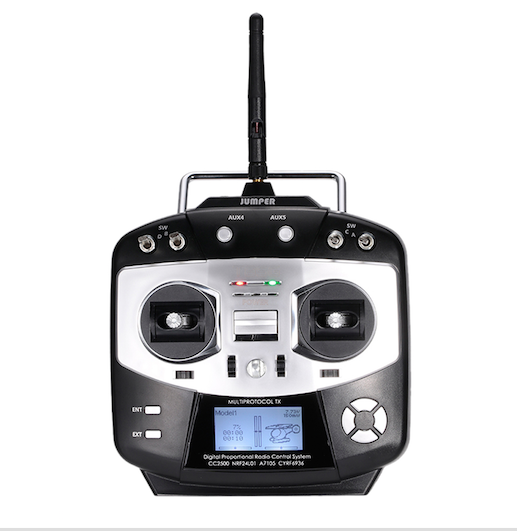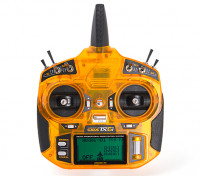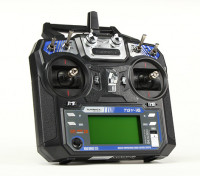FlySky RC (not FrSky Taranis - that's a competitor)
FlySky transmitters are produced by FlySky RC from China, with roots as budget conscious brand that focuses on both air and surface hobby grade radio control products. FlySky radios have been a strong competitor for the HobbyKing / Turnigy / Orange budget radios due to their price point, and recently are moving "up market" with more capable computer based radios including features like telemetry and multi-protocol compatible radio modules and trend-breaking (or setting?) style & formats.
FlySky radios use the AFHDS and AFHDS 2 protocols so they are not compatible with Spektrum / FrSky / Graupner etc receivers or most Bind and Fly (BNF) planes and drones made before 2017 (unless using an external radio module with the FS Nirvana). However there are starting to be some BNF quadcopters using the FlySky protocols in the market.
I started back into the RC hobby with the FS-i4 and a FT Tiny Trainer and it served me well for a few months before I upgraded to the FS-i6. Then after about 6 months I dove in to the OpenTx FrSky Taranis world. I also know several people at my club happily flying the FS-i6 a couple years into the hobby. I believe these are very viable transmitters (especially the FS-i6) for people getting into the hobby who don't want to spend a lot of money but do want a radio that could last them for several airplane or drones.
Models
FlySky FS-i4 4-Channel Transmitter - ~$40 US w/ 1 receiver
Pros:
- This radio is a frequent choice for new DIY RC folks on a budget - lots of people with experience to help
- Capable of reversing servo direction (via manual switches)
- Additional receives can be purchased for ~$16 US unlike cheaper WL Toys radios
Cons:
- Only 4 channels. This limits the types of models it will work with. Use of a Y cable for dual aileron servos will get your FT Storch in the air with this though.
- It can only be bound to one model at a time - no easy switching between planes
- The trims and servo direction settings need to be reset when binding to a new receiver (cause it's manual).
- It feels like a cheap hunk of plastic. But it's a cheap hunk of plastic that will get you flying!
FlySky FS-i6 6-Channel Transmitter ~ $55 US w/ 1 receiver
Pros:
- 6 channels! This will handle the majority of flying aircraft for the average DIY person's first couple years
- Multiple compatible receivers for sale including ones that supports PPM / iBus / sBus for single wire flight controller connections (very important for modern quads)
- Capable of basic computer radio functions like servo reversing, dual rates, and expo
- 20 Model Memory!
- AFHDS 2A protocol capable for telemetry support
- Very simple to use interface
- Supports trainer/student radio buddy boxing with PS/2 cables (different cable type compared to Spektrum or FrSky - custom cable conversion hacks have been documented for the true hackers out there)
- Can be used with computer simulators with a PS/2 to USB cable
- Community developed firmware available that expands the radio to 10 channel capability
- Lots of community hacks and 3D printed accessories on the interwebs
Cons:
- Very limited mixing - only 3 per model and basic in function compared to OpenTx capabilities
- Still feels like a cheap piece of plastic with questionable styling

Flysky FS-I6S 10 channel ~$55 US
Pros:
- It's pretty, especially if you're into the Apple design look.
- Specs wise it's pretty much an FS-i6
- Has a touch screen
- 10 radio channels
- Telemetry
- Built in mounting point for a phone holder (useful for wi-fi based FPV)
Cons:
- No trim buttons makes it difficult to get a "hands off" flying experience with most planes (not an issue for quads though)
- Two power buttons doubles the opportunity to accidentally turn it off while flying with it.
- Suspect no mixing support (means no delta or flying wing or v-tail style models)
Flysky FS-i10 10 Channel ~ $180 US (discontinued but old stock still available)
Pros:
- 10 channels! This will handle the majority of flying aircraft except for the most complex giant scale or detailed models
- Multiple compatible receivers for sale including ones that supports PPM / iBus / sBus for single wire flight controller connections (very important for modern quads)
- Advanced computer radio functions; timers, servo reversing, dual rates, custom expo curves, custom switch assignments, delays & logical switches
- 20 Model Memory!
- AFHDS 2A protocol capable for telemetry support
- Comes with 4 telemetry sensors including temperature, RMP (magnetic & optical), & voltage
- Simple to use full color LCD interface with custom model picture capability
- Supports trainer/student radio buddy boxing with standard audio cables (compatible with most Spektrum, FrSky, etc)
- Can be used with computer simulators with a trainer port to USB cable
Cons:
- Pricing comparable to the Taranis X9D, but a little lower in capability
- Still less solid feeling than most FrSky or Specktrum transmitters - but better than the FlySky budget options!
- Discontinued - you can still find old stock of these on eBay and some retailers, but FlySky has moved manufacturing on to the Nirvana model
Flysky Nirvana Dark Knight TX 14 Channel Radio ~$180 US
Pros:
- Wow - completely different form factor from traditional RC transmitters!
- Hall effect high quality gimbals
- High quality switches and radio feel - not a cheap piece of plastic feeling
- 3D printed custom grips & switch components released open source
- OpenTX software - currently on an alpha branch, but expected to merge into the main software trunk
- Full color LCD interface with custom model picture capability, custom audio, etc. - see OpenTx capabilites
- 14 channels! This will handle the majority of flying aircraft except for the most complex giant scale or detailed models
- Multiple compatible receivers for sale including ones that supports PPM / iBus / sBus for single wire flight controller connections (very important for modern quads)
- Advanced computer radio functions; timers, servo reversing, dual rates, custom expo curves, custom switch assignments, delays & logical switches
- Radio Module bay - compatible with multi-protocol / Spektrum / FrSky / Crossfire long range radio modules including telemetry support
- 260 Model Memory! (thank you OpenTX - unlimited model memory if you carry extra SD cards)
- Audio feedback & background sound capable
- Bluetooth module capable (remotely reprogram your flight controllers!)
- AFHDS 2A protocol capable for telemetry support
- Supports trainer/student radio buddy boxing with standard audio cables (compatible with most Spektrum, FrSky, etc)
- Can be used with computer simulators with a trainer port to USB cable
Cons:
- It's new on the market (as of summer 2018) - reviews and help at the field will be limited for a while
- Currently using a custom branch of OpenTX (expected to merge into main software version)
FlySky / Turnigy 9X (and variants)
This is an older radio, and was a great DIY / hackers platform back in the early 2010's. If you get one for free or $20 at a swap meet, it's very usable, but is out of production and outclassed by many other options on the market today. See
@pressalltheknobs more detailed write up on this model
https://forum.flitetest.com/index.php?threads/which-transmitter-you-should-buy.37966/post-432028
Other Models
Flysky also produces several surface "trigger style" 3 channel radios that are good options for RC cars and boats, but are generally not going to be comfortable for RC aircraft flying. Though it could be fun to hook up a 3 channel glider / trainer to one of these for a lark...






























